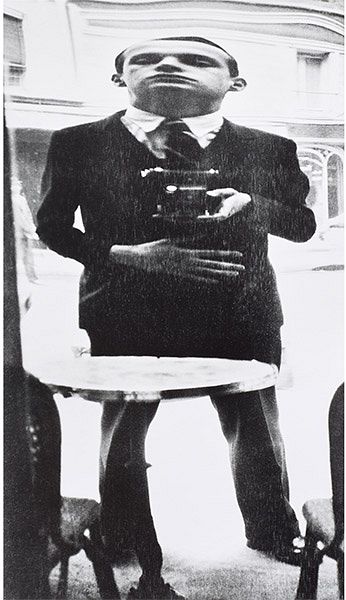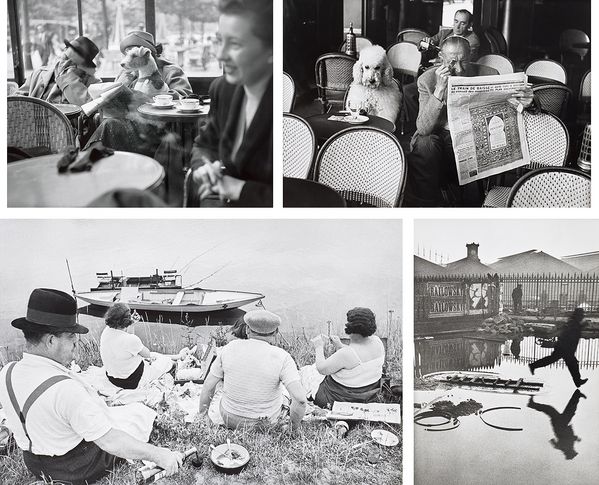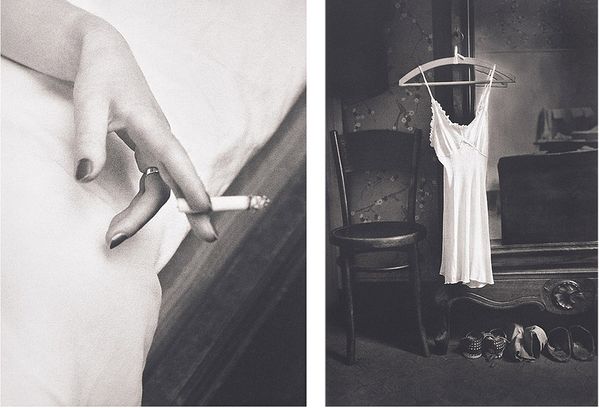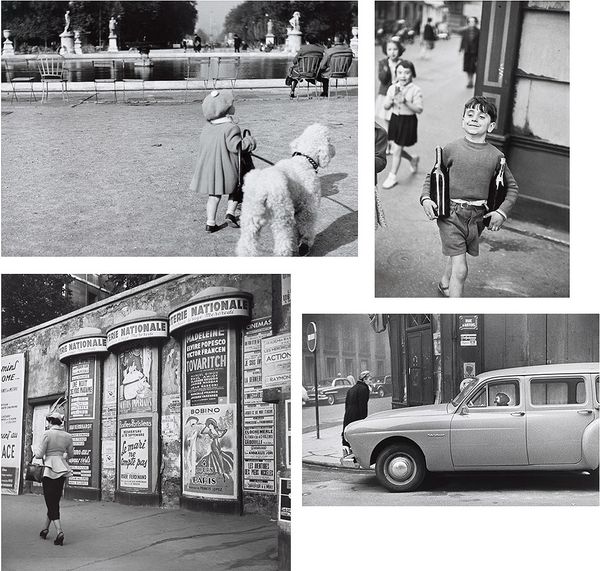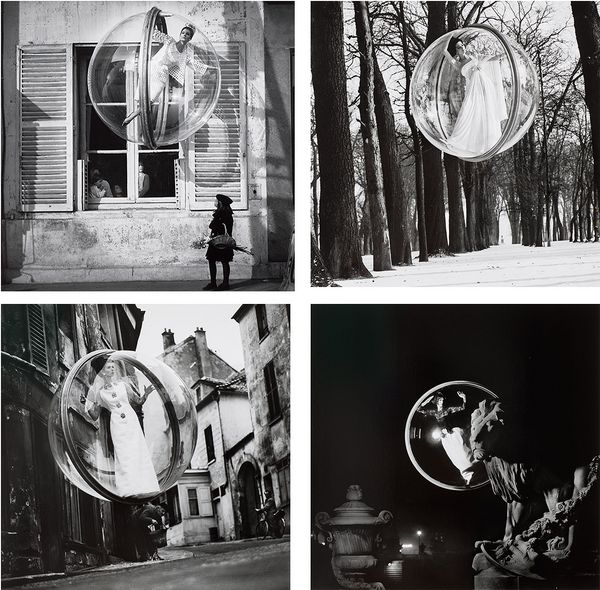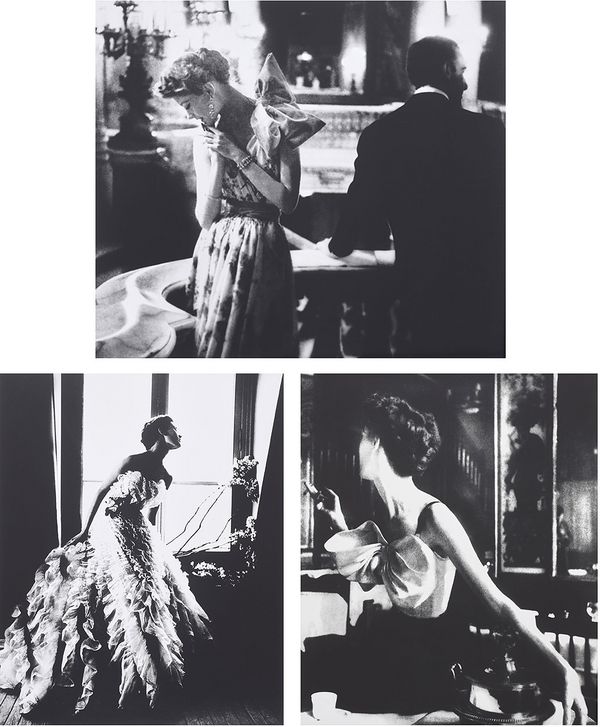Henri Cartier-Bresson, Behind the Gare St. Lazare, Paris, 1932 (Lot 2). Impressions Parisiennes: Une Collection de Photographies.
Impressions Parisiennes
The spirit of Paris comes alive in 'Impressions Parisiennes: Une Collection de Photographies' — a single owner collection to be offered at auction in Paris on 30 November. View sale.
Prepare to Be Inspired...
We immediately recognize so many of these poetic pictures as exemplars of the French "humanist" tradition — as well as their immediate forebears and heirs. An iconic selection, many were originally widely illustrated and continue to cast their spell over our cultural consciousness. This is Paris the way we feel it.
French humanist photographs tend to be spontaneous, yet composed, contemplative, and often witty open-ended narratives unfolding in a single frame. The subject is ordinary people experiencing the smallest of everyday personal triumphs. It is also Paris. That is important. The setting is always key as we look at people out and about in their native environment. The images communicate everyday moments relatably and, on a more satisfying level, express how we imagine Paris as a magical, mysterious dream.
Paris by Day, Paris by Night
Left: Henri Cartier-Bresson, Île de la Cité, Paris, 1952 (Lot 5). Right: Willy Ronis, Pont Alexandre III, Paris. 1957 (Lot 64). Impressions Parisiennes: Une Collection de Photographies.
Starting in the interwar period, the French humanist photographers stepped out of the studio and into the street. They took great interest in the most visited Parisian locales — capturing with technical finesse the settings' nuanced beauty in natural light.
A true pioneer of photography as art, Henri Cartier-Bresson (1908 – 2004) started as a painter but was inspired to pursue photography after seeing works by Martin Muncáski in Arts et Métiers Graphiques, as well as images by Eugène Atget, and Man Ray. In 1933, Cartier-Bresson purchased his first 35mm Leica camera, perfectly portable and discreet enough for the spur-of-the-moment style he would soon be renowned for. In 1947, he co-founded with Robert Capa the important cooperative photo agency Magnum Photos. A master of composition, he was to have a deep and abiding influence on many of the great talents of this age. “In order to ‘give a meaning’ to the world,” he wrote, “one has to feel involved in what one frames through the viewfinder. This attitude requires concentration, discipline of mind, sensitivity, and a sense of geometry. It is by economy of means that one arrives at simplicity of expression.”
Another giant of the era in Paris is Willy Ronis (1910 – 2010). Having honed his masterful sense of proportion and composition working in his parents’ photography studio, he went on to become the first French staff photographer for LIFE magazine — which brought his images to millions of people in America and around the world. In 1946, he joined Rapho, the other preeminent photo agency for the French humanist photographers of that era.
Notably, both Ronis and Cartier-Bresson featured in Edward Steichen's groundbreaking exhibitions at The Museum of Modern Art (MoMA) in New York — Five French Photographers, 1952 and The Family of Man, 1955.
Turning the Camera
Henri Cartier-Bresson, Autoportrait, Paris, c. 1932 (Lot 21). Impressions Parisiennes: Une Collection de Photographies.
The influence of the Surrealists, with whom Henri Cartier-Bresson socialized at the Café Cyrano in the Place Blanche, is clearly evident in the magnificent distortions of his Self-Portrait, 1932. Like Aragon, Breton, and others, he’d taken to the streets on a quest to discover unpredictable meanings in scenes both unusual and dramatically commonplace.
“The Decisive Moment”
From top left: René Groebli, #1674, Scène de Café, Paris, 1948 (Lot 31). Édouard Boubat, Les Deux Magots, Paris, 1952 (Lot 30). Henri Cartier-Bresson, Dimanche sur les Bords de la Marne, Paris, 1938 (Lot 4). Henri Cartier-Bresson, Behind the Gare St. Lazare, Paris, 1932 (Lot 2). Impressions Parisiennes: Une Collection de Photographies.
It was de rigeur in the tradition of the French humanist photographers to roam the environs of Paris as a hunter seeking to capture intimate poetic glimpses of ordinary people. Henri Cartier-Bresson developed the concept of the “decisive moment,” when everything in the frame fell into perfect composition for a brief instant of time. It was to become a rallying cry and source of inspiration for many of his fellow French humanist photographers.
In 1943, while doing forced labor in Nazi Germany, Édouard Boubat (1923 – 1999) witnessed the atrocities of war firsthand and it forever transformed his perspective. Another of the French humanist photographers in The Family of Man, he didn’t take his first picture until 1946. Notably, he was swept up by the French magazine Réalités only a year later, after winning the Kodak Prize. An adventurer, he was to travel the world to shoot local communities in far-flung locales. Also a paradigmatic humanist, his benign, apolitical editorials on international affairs led poet Jacques Prévert to call him a "peace correspondent."
Mon Amour
Two images from the portfolio L’Œil de l’Amour (The Eye of Love), 1952 (Lot 27). Impressions Parisiennes: Une Collection de Photographies.
Zurich-born photographer René Groebli (1927 –) established his place as a master photo essayist among European post-war artists with two iconic portfolios — Rail Magic, 1949 and L’Œil de l’Amour (The Eye of Love), 1952. Groebli shot the latter, featured in the present auction, in a shabby Parisian hotel room on his honeymoon as a testament to his love for his wife. He aimed in his photo stories less to document than to capture the emotions of his subjects through the atmosphere of their surroundings and to inspire associations. By the early 1950s, Groebli was working as a photographer for LIFE, Picture Post, Illustrated, Time and other international magazines, as well as participating in the first Subjektive Fototgraphie exhibition in Saarbrüken. In 1955, he was also included in the The Family of Man exhibition at MoMA.
A Stroll in the City
From top left: Dorothy Bohm, Jardin des Tuileries, Paris, 1953 (Lot 54). Henri Cartier-Bresson, Rue Mouffetard, Paris, 1954 (Lot 1). Janine Niepce, L'Elegante et les Colonnes Morris, Paris, 1950 (Lot 46). Elliot Erwitt, Paris, 1957 (Lot 29). Impressions Parisiennes: Une Collection de Photographies.
One identifies with the people in these images. The French humanist photographers typically showed great empathy for their subjects. Many wished to express solidarity with a wide range of humanity from all classes of society. Never posed, the images always feel natural and authentic.
Janine Niépce (1921 – 2007), a French humanist photographer born and raised in Paris, is championed for being among the first photojournalists in France and for her sustained focus on the women’s movement and portraits of women that brought to life their beauty and power in the midst of great historical changes. A distant cousin of Nicéphore Niépce, an inventor of photography and on the board of that eponymous museum, she joined the Rapho agency in 1955 and was for her own accomplishments made a Chevalier des Arts et des Lettres and a Chevalier de la Légion d’Honneur.
A Bubble of Her Own
From top left: Melvin Sokolsky, Flower Girl Faces, 1963 (Lot 14). Melvin Sokolsky, three photos from Paris, 1963 (Lot 15). Impressions Parisiennes: Une Collection de Photographies.
A new age of euphoria touched Paris in the 1960s. Melvin Sokolsky’s 1963 Paris portfolio of floating space-age bubbles is among the most arresting, iconic, and memorable in fashion history. Much of his source material came from processing idiosyncratic lifelong fascinations. As to the origin of this imagery: he credited his father with first showing him an image of Hieronymus Bosch’s Garden of Earthly Delights. Later, when sick with fever, he had recurrent dreams of travelling to faraway lands in a Bosch-inspired bubble. An idea man and a consummate technician, he made it happen. He had the Plexiglass bubbles fabricated by aeronautics engineers and used cranes and cables to suspend them in the air, later removing any vestigial evidence from the negative.
Melvin Sokolsky (1933 – 2022) was born and raised in New York City. At the age of 21, he was invited to join the staff of Harper's Bazaar. Within the next few years, he worked as a major contributor to Esquire, McCall's Newsweek, and Show, visiting Paris intermittently for his most exciting and inspired shoots. Celebrated as a technical master, he exemplified the free, experimental attitude of the 1960s, helping to pioneer fantasy illusions in fashion photography — long before the digital age — and extending the limits of what was possible.
Timeless Elegance
From top left: Lillian Bassman, Paris Gala Night: Barbara Mullen in a Dress by Patou, Harper's Bazaar, Paris, 1949 (Lot 36). Lillian Bassman, Fantasy on the Dance Floor: Barbara Mullen in a Christian Dior Dress, Paris. Harper's Bazaar, 1949 (Lot 35). Lillian Bassman, Across the Restaurant, Barbara Mullen, dress by Jacques Fath, Le Grand Véfour, Paris, 1949 (Lot 33). Impressions Parisiennes: Une Collection de Photographies.
Influenced by Surrealists such as Man Ray, Lillian Bassman (1917 – 2012) pioneered a language of grain, chiaroscuro, off-kilter angles and self-possessed figures to create images that are mysterious, dream-like visions. Her distinctive aesthetic, which complemented the exciting new fashions, achieved tremendous success. Bassman’s unique approach was to be a seminal influence on many artists during the 1960s.
The French humanist tradition was a great coming together of natives and seekers from abroad who together dared to reinvent their beloved Paris as a modern mecca of cosmopolitan cultural effervescence — a stunning heritage and source of endless inspiration.
Discover More from Photographs >
Recommended Reading
ULTIMATE STEVEN KLEIN: From A Master’s Archive >
Specialists' Picks: The Hong Kong Watch Auction: XVII >


